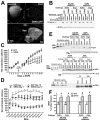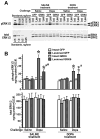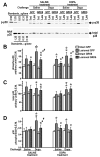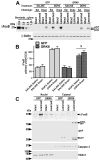Overexpression of GRK6 rescues L-DOPA-induced signaling abnormalities in the dopamine-depleted striatum of hemiparkinsonian rats
- PMID: 25687550
- PMCID: PMC4464750
- DOI: 10.1016/j.expneurol.2015.02.008
Overexpression of GRK6 rescues L-DOPA-induced signaling abnormalities in the dopamine-depleted striatum of hemiparkinsonian rats
Abstract
l-DOPA therapy in Parkinson's disease often results in side effects such as l-DOPA-induced dyskinesia (LID). Our previous studies demonstrated that defective desensitization of dopamine receptors caused by decreased expression of G protein-coupled receptor kinases (GRKs) plays a role. Overexpression of GRK6, the isoform regulating dopamine receptors, in parkinsonian rats and monkeys alleviated LID and reduced LID-associated changes in gene expression. Here we show that 2-fold lentivirus-mediated overexpression of GRK6 in the dopamine-depleted striatum in rats unilaterally lesioned with 6-hydroxydopamine ameliorated supersensitive ERK response to l-DOPA challenge caused by loss of dopamine. A somewhat stronger effect of GRK6 was observed in drug-naïve than in chronically l-DOPA-treated animals. GRK6 reduced the responsiveness of p38 MAP kinase to l-DOPA challenge rendered supersensitive by dopamine depletion. The JNK MAP kinase was unaffected by loss of dopamine, chronic or acute l-DOPA, or GRK6. Overexpressed GRK6 suppressed enhanced activity of Akt in the lesioned striatum by reducing elevated phosphorylation at its major activating residue Thr(308). Finally, GRK6 reduced accumulation of ΔFosB in the lesioned striatum, the effect that paralleled a decrease in locomotor sensitization to l-DOPA in GRK6-expressing rats. The results suggest that elevated GRK6 facilitate desensitization of DA receptors, thereby normalizing of the activity of multiple signaling pathways implicated in LID. Thus, improving the regulation of dopamine receptor function via the desensitization mechanism could be an effective way of managing LID.
Keywords: Akt; ERK1/2; GRK6; JNK; Lentivirus; Parkinson's disease; l-DOPA-induced dyskinesia; p38; ΔFosB.
Copyright © 2015 Elsevier Inc. All rights reserved.
Figures







Similar articles
-
G protein-coupled receptor kinases as regulators of dopamine receptor functions.Pharmacol Res. 2016 Sep;111:1-16. doi: 10.1016/j.phrs.2016.05.010. Epub 2016 May 10. Pharmacol Res. 2016. PMID: 27178731 Free PMC article. Review.
-
Striatal overexpression of β-arrestin2 counteracts L-dopa-induced dyskinesia in 6-hydroxydopamine lesioned Parkinson's disease rats.Neurochem Int. 2019 Dec;131:104543. doi: 10.1016/j.neuint.2019.104543. Epub 2019 Sep 3. Neurochem Int. 2019. PMID: 31491493
-
Pharmacological antagonism of histamine H2R ameliorated L-DOPA-induced dyskinesia via normalization of GRK3 and by suppressing FosB and ERK in PD.Neurobiol Aging. 2019 Sep;81:177-189. doi: 10.1016/j.neurobiolaging.2019.06.004. Epub 2019 Jun 19. Neurobiol Aging. 2019. PMID: 31306812
-
Effect of repeated L-DOPA, bromocriptine, or lisuride administration on preproenkephalin-A and preproenkephalin-B mRNA levels in the striatum of the 6-hydroxydopamine-lesioned rat.Exp Neurol. 1999 Feb;155(2):204-20. doi: 10.1006/exnr.1998.6996. Exp Neurol. 1999. PMID: 10072296
-
Involvement of canonical and non-canonical D1 dopamine receptor signalling pathways in L-dopa-induced dyskinesia.Parkinsonism Relat Disord. 2009 Dec;15 Suppl 3:S64-7. doi: 10.1016/S1353-8020(09)70783-7. Parkinsonism Relat Disord. 2009. PMID: 20083011 Review.
Cited by
-
Arrestin-3-assisted activation of JNK3 mediates dopaminergic behavioral sensitization.Cell Rep Med. 2024 Jul 16;5(7):101623. doi: 10.1016/j.xcrm.2024.101623. Epub 2024 Jun 26. Cell Rep Med. 2024. PMID: 38936368 Free PMC article.
-
Dopamine D1 receptor signalling in dyskinetic Parkinsonian rats revealed by fiber photometry using FRET-based biosensors.Sci Rep. 2020 Sep 2;10(1):14426. doi: 10.1038/s41598-020-71121-8. Sci Rep. 2020. PMID: 32879346 Free PMC article.
-
Signal transduction in L-DOPA-induced dyskinesia: from receptor sensitization to abnormal gene expression.J Neural Transm (Vienna). 2018 Aug;125(8):1171-1186. doi: 10.1007/s00702-018-1847-7. Epub 2018 Feb 2. J Neural Transm (Vienna). 2018. PMID: 29396608 Free PMC article. Review.
-
G protein-coupled receptor kinases as regulators of dopamine receptor functions.Pharmacol Res. 2016 Sep;111:1-16. doi: 10.1016/j.phrs.2016.05.010. Epub 2016 May 10. Pharmacol Res. 2016. PMID: 27178731 Free PMC article. Review.
-
The lentiviral-mediated Nurr1 genetic engineering mesenchymal stem cells protect dopaminergic neurons in a rat model of Parkinson's disease.Am J Transl Res. 2018 Jun 15;10(6):1583-1599. eCollection 2018. Am J Transl Res. 2018. PMID: 30018702 Free PMC article.
References
-
- Ahmed MR, Berthet A, Bychkov E, Porras G, Li Q, Bioulac BH, Carl YT, Bloch B, Kook S, Aubert I, Dovero S, Doudnikoff E, Gurevich VV, Gurevich EV, Bezard E. Lentiviral overexpression of GRK6 alleviates L-dopa-induced dyskinesia in experimental Parkinson’s disease. Sci Transl Med. 2010;2:28ra28. - PMC - PubMed
Publication types
MeSH terms
Substances
Grants and funding
LinkOut - more resources
Full Text Sources
Other Literature Sources
Research Materials
Miscellaneous

